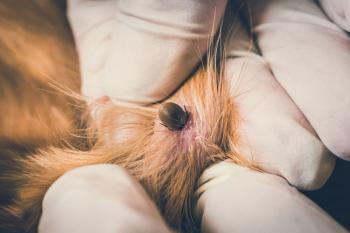
The growing family of flea preventives: What to pick for what (Proceedings)
Fleas are still the most common cause for parasite induced pruritic skin problems. Since the nineteen's many different drugs and preventative have been introduced to prevent and to treat flea infestation, and certainly the occurrence of severe widespread infestations have declined.
Fleas are still the most common cause for parasite induced pruritic skin problems. Since the nineteen's many different drugs and preventative have been introduced to prevent and to treat flea infestation, and certainly the occurrence of severe widespread infestations have declined. However, the lack of pet owner compliance and neglect of addressing environmental flea infestation are probably the most common causes for a chronic recurring flea problem. Once a home is infested, control is often difficult, time-consuming and expensive, and so a lot of emphasis should be concentrated to prevention. Successful eradication of a flea infestation requires knowing the specifics of the flea life cycle and the mechanisms and efficacy of available flea preventatives. Although concern has been raised of fleas developing resistance to some of the commonly used topical flea preventatives (e.g. Frontline), these reports are rather anecdotal and have not been confirmed by controlled studies so far. At this point we have to consider that the "appearance of flea resistance" is more likely due to lack of compliance and knowledge about the flea life cycle, as well as unrealistic expectations from the flea product dispensed by veterinarians.
Flea biology
The flea life cycle of Ctenocephalides felis felis consists of 4 main stages and is completed between 21-174 days. Most adult fleas live on animals, but adult fleas make only ~5% of the entire flea population, whereas the rest (eggs, larvae and pupae) live in the pet's environment. Female fleas start to produce eggs, approximately 24 hours after their first blood meal. Adult fleas can survive up to 100 days and produce 40-50 eggs per day! Flea eggs usually fall of the animal and will hatch within 2-10 days. The larval stage is the most sensitive stage and less than 25% will survive. Heat, cold, dryness and limited food supply (organic debris) is the limiting factor for the survival of the larval stage. For this reason the larvae seek protection by crawling (up to 40cm) into deeper areas of the carpet, underneath furniture, etc. After two molts the third larval stage enters the pupal stage. The pupa is resistant to desiccation and temperatures of >3°C and <35°C. The flea remains in the pupal stage 5 to 140 days depending on the environmental condition (ideal: 27°C, 80% humidity, mechanical pressure, vibration). If the environmental conditions are ideal, it is not unusual that many fleas will emerge from the pupal stage at once and cause a sudden outbreak.
For indoor only pets a flea growth inhibitor may be enough as a preventative. However, pets with outdoor exposure are more likely to get in contact with fleas. In these animals a preventative with a fast-acting adulticide will interrupt the flea life cycle before the flea has a chance to establish indoor. Urban wildlife such as opossum, raccoon, coyote, fox and feral cats are important carriers of fleas and potential source for infesting a pet owner's yard. Removing and/or limiting access to areas such as crawl spaces, dark areas under decks, garage, door mats, cat and dog food put outside, moist dark areas under shrubs and piles of leaf and limb will help to minimize the areas for fleas to establish.
Flea preventatives
Flea allergic dermatitis or flea bite hypersensitivity is commonly present in atopic patients, and so effective and strict monthly flea prevention is imperative. Because owners often don't see the fleas on their pets and don't understand the concept of flea allergic dermatitis they are often arguing about the sense of a strict flea prevention protocol. It is very important to explain to the owner that none of the currently available flea preventatives is 100% effective to stop exposure to a flea. However, products containing fast-acting adulticides (e.g. Comfortis) will be able to prevent flea egg production, but not the biting and feeding before they die. Scientists have shown that once a flea gets in contact with a pet, biting and feeding occurs within few minutes. Despite this deficiency, the use of a fast-acting adulticides will reduce pruritus due to the reduction of the flea burden in the pet's environment.
Don't forget that all pets in the household should be treated at the same time. If a flea infestation has established in the pet's environment topical or oral flea preventatives alone will not be able to eliminate the problem immediately. In fact it can take several months until the flea population starts to decrease. For this reason a combination of flea prevention and environmental control and treatment should be initiated to achieve a successful and quick elimination of the flea problem.
Newsletter
From exam room tips to practice management insights, get trusted veterinary news delivered straight to your inbox—subscribe to dvm360.





